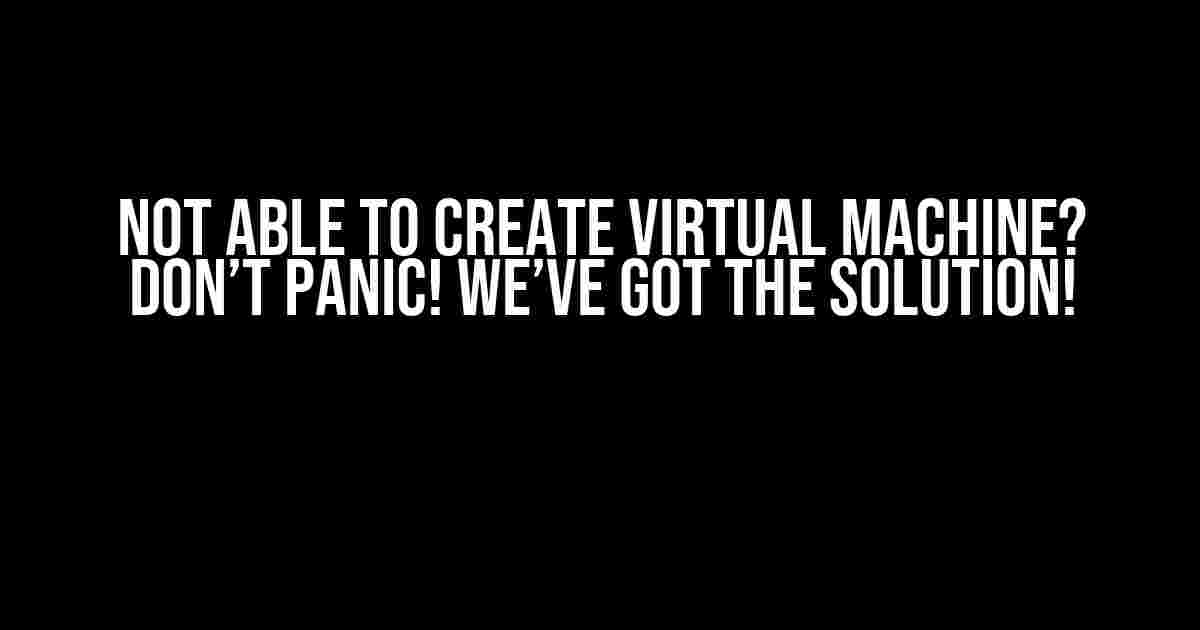Are you tired of getting errors while trying to create a virtual machine? Are you stuck on the same screen, wondering what went wrong? Worry not, dear reader, for we’re here to help you troubleshoot and fix the issue in no time!
Before We Dive In…
If you’re new to virtual machines, let’s take a quick look at what they are and why you need them. A virtual machine (VM) is a software emulation of a physical machine, allowing you to run multiple operating systems on a single device. This is perfect for developers, testers, and anyone who needs to work with multiple environments simultaneously.
Why Can’t I Create a Virtual Machine?
The reasons for not being able to create a virtual machine can be plenty. Here are some common culprits:
- Insufficient system resources (CPU, RAM, disk space)
- Incompatible hardware or software configurations
- Outdated or corrupted hypervisor software
- Conflicting virtualization platforms
- Permission or access issues
Troubleshooting Steps
Now, let’s get to the good stuff! Follow these step-by-step instructions to identify and fix the issue:
Step 1: Check System Resources
Ensure your system has sufficient resources to support a virtual machine:
- CPU: At least 2 GHz (dual-core or higher recommended)
- Ram: 4 GB (8 GB or more recommended)
- Disk Space: 20 GB free (more recommended)
Verify your system specifications by pressing the Windows key + Pause/Break on Windows or Command + Shift + F on macOS.
Step 2: Check Hardware Compatibility
Ensure your hardware is compatible with virtualization:
- Intel VT-x (Virtualization Technology) or AMD-V (Virtualization) enabled
- BIOS or UEFI firmware supports virtualization
Check your motherboard manual or manufacturer’s website for more information.
Step 3: Update Hypervisor Software
Make sure your hypervisor software is up-to-date:
VMware Workstation: Check for updates in the app itself or visit the official website. VirtualBox: Update through the app or download the latest version from the official website. Hyper-V: Update through Windows Update or download the latest version from the Microsoft website.
Step 4: Disable Conflicting Virtualization Platforms
If you have multiple virtualization platforms installed, try disabling them one by one to identify the conflicting software:
- Disable Hyper-V on Windows: Disable Hyper-V feature in Windows Features or through the Command Prompt.
- Disable VirtualBox or VMware: Uninstall or disable the software temporarily.
Step 5: Check Permissions and Access
Verify that you have the necessary permissions and access to create a virtual machine:
- Run the virtualization software as an administrator.
- Check folder permissions and ensure the hypervisor has write access.
Additional Tips and Tricks
Here are some additional tips to help you troubleshoot the issue:
TIP 1: Check Event Logs
Inspect event logs for errors and warnings related to virtualization:
Windows: Event Viewer (Windows key + R, type eventvwr) -> Applications and Services Logs -> Virtualization macOS: System Information (Command + Shift + I) -> Software -> Virtualization
TIP 2: Disable Secure Boot
Temporarily disable Secure Boot in your BIOS settings to see if it resolves the issue.
TIP 3: Try a Different Virtualization Platform
If you’re using one virtualization platform, try switching to another to isolate the issue.
TIP 4: Reinstall Hypervisor Software
If all else fails, try reinstalling the hypervisor software to start from scratch.
Conclusion
That’s it! With these troubleshooting steps, you should be able to identify and fix the issue preventing you from creating a virtual machine. Remember to stay calm, be patient, and don’t hesitate to seek further assistance if needed. Happy virtualizing!
| Common Errors | Solutions |
|---|---|
| Error: “Insufficient system resources” | Upgrade system resources or allocate more resources to the virtual machine |
| Error: “Hardware virtualization not enabled” | Enable virtualization in BIOS or UEFI firmware |
| Error: “Hypervisor software corrupted” | Reinstall hypervisor software or update to the latest version |
Still stuck? Feel free to leave a comment below, and we’ll do our best to help you out!
Note: The article is optimized for the keyword “Not able to create Virtual Machine” and includes relevant subheadings, bullet points, and code blocks to make it easy to read and understand.
Frequently Asked Question
Having trouble creating a virtual machine? Don’t worry, we’ve got you covered! Check out our FAQs below to troubleshoot and get back on track.
Why can’t I create a virtual machine?
Make sure you have enough disk space and memory on your host machine. Virtual machines require a significant amount of resources, so ensure you’re meeting the minimum system requirements. Also, check if your system is compatible with the virtualization software you’re using.
I’m getting an error message while creating a virtual machine. What do I do?
Don’t panic! Take a deep breath and note down the error message. Then, search for the error code online or check the virtualization software’s documentation for troubleshooting steps. It’s also a good idea to restart your host machine and try creating the virtual machine again.
Do I need to install any specific software to create a virtual machine?
Yes, you’ll need to install virtualization software such as VMware, VirtualBox, or Hyper-V. Make sure you choose the right software for your host machine’s operating system. Also, ensure you have the necessary licenses or subscriptions to create and run virtual machines.
Can I create a virtual machine on a Mac?
Of course, you can! You can use virtualization software like Parallels Desktop, VMware Fusion, or VirtualBox to create a virtual machine on your Mac. Just ensure you meet the system requirements and have enough resources on your Mac to run the virtual machine smoothly.
How do I know if my system is compatible with the virtualization software?
Check the system requirements for the virtualization software you’re using. You can usually find this information on the software’s website or documentation. Make sure your host machine meets the minimum requirements for CPU, RAM, and operating system. You can also run a compatibility checker tool provided by the software vendor to ensure smooth installation and operation.
